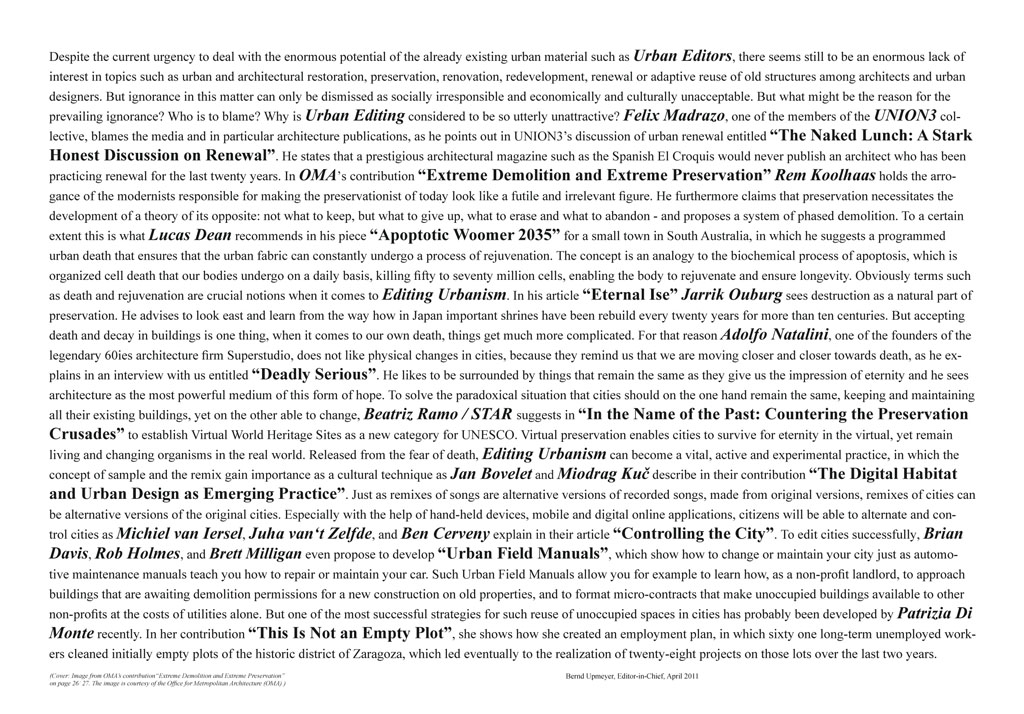10-10-11 // THE URBAN EDITOR

Editorial of MONU #14 on “Editing Urbanism”
The Urban Editor
By Bernd Upmeyer
In the near future, the interior architect might be best positioned to become the ultimate designer of space, replacing and eradicating professions such as architect and urban designer. But to become such an important figure, the interior architect has to move ahead and reinvent and transform himself into an advanced and superior version of his own existence and become an “Urban Editor” with an extended knowledge of the heritage and history of the cultural landscape and the urban environment. To succeed in the future he will have to face the past. But the interior architect has lived long enough as a Clark Kentian “mild-mannered reporter” in the metropolis of our planet. As urban editor he may leave his bespectacled old ego behind and display the super-abilities of the interior architect.
As urban editors, interior architects will dominate the architectural and urban design profession of the future, since these days, the need for new buildings or entire city quarters is decreasing or even ceasing to exist altogether – at least in the Western world – due to demographic changes and financially difficult times. In such times, when large-scale master plans are no longer sufficient design tools, design tasks will shift from new buildings to existing buildings and especially to the interiors of the existing buildings. Therefore, interior architects will be best prepared for the future; especially those who were trained by schools that focused their education first and foremost on the past and mainly taught urban and architectural restoration, preservation, renovation, redevelopment, or adaptive reuse of old structures, whereby cities will be edited rather than extended or even newly designed.
In such a future, which has become reality in most Western cities of this day and age, interior architects will be successful as urban editors. But it will probably become reality, too, in emerging and developing economies such as China, Brazil, or India, where historical city areas are currently being bulldozed out of existence by excessive development. Urban editors will be released from the modernistic burden to constantly replace the old world with a new one. Their daily tasks will first of all be based on re-designing, re-programming, and renovating the interiors of the existing urban fabric according to changing needs. But they will be also involved in processes of selecting, correcting, condensing, organizing, or modifying the existing urban material. The process of urban editing will originate from an idea for the existing urban structure itself and will continue in a relationship between the users and producers of the city and the urban editors. Urban editing, therefore, will be also a practice that includes creative skills, human relations, and a precise set of methods.
But the question is: what kind of methods will the urban editor use? What will be his task exactly? What will the process of urban editing look like? With what kind of challenging problems will the urban editor be confronted and how will he solve them? How will he assess how to deal with the existing structures, and with the preserved and protected elements of the city? Will it be the job of the urban editor to define the value of existing urban structures? Which structures will he keep and which will he destroy? How should he deal with urban nostalgia for history, and how with memory? What will be his criteria for action, his values, his moral compass? Or will the urban editor be merely the mediator between the old and the new in general?
Title: Urban Editor
Author: Bernd Upmeyer
Date: October 2011
Type: Commissioned article
Publications: Hiatus
Publisher: Sanserif
Location: Valencia, Spain
Pages: 20-21